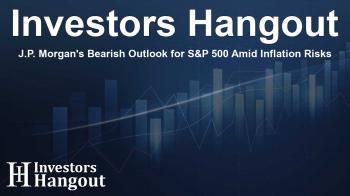J.P. Morgan's Bearish Outlook for S&P 500 Amid Inflation Risks

J.P. Morgan's Cautious Position on the S&P 500
Recent analyses by investment banking giant J.P. Morgan reveal a considerable shift in their outlook for the S&P 500. Despite a strong performance earlier in the year, J.P. Morgan analysts anticipate a more cautious trajectory as they project the index could close the year at 6,000. This would reflect a decline of approximately 3.7% from its current position, highlighting a significant pivot in expectations.
As the year progresses, the S&P 500 has seen a year-to-date increase of around 6%. Should the index indeed drop to the forecasted 6,000 by year-end, it would result in a modest gain of 2% for the year, a stark contrast to earlier predictions of a 6,500 close.
Interestingly, J.P. Morgan's outlook diverges from its optimism concerning international stocks. The analysts expect a favorable trajectory for international indices, forecasting the MSCI Eurozone index to hit 345, representing a 9% increase, while the FTSE 100 is anticipated to reach 9,000, indicating a 3% growth. This juxtaposition underscores a broader strategy in navigating varying global market conditions.
Economic Uncertainties and the Risk of Recession
While J.P. Morgan maintains an expectation of double-digit growth in corporate earnings, the broader economic landscape remains uncertain, particularly with ongoing tariff developments. Analysts express concern regarding the resilience of the economy amid increasing tariffs that currently surpass the 20% mark.
“The economy and consumers have shown resilience, and corporates delivered healthy growth of 12% despite the increased tariff rates,” noted Dubravko Lakos-Bujas, who leads Global Markets Strategy at J.P. Morgan. “Positioning may support equities in the short term; however, we remain vigilant about potential economic slowing in the latter half of the year.”
J.P. Morgan’s economists identify a 40% likelihood of a recession occurring in the latter part of the year. This prediction is based on anticipated slower economic activity and potential inflationary pressures that could adversely affect consumer purchasing power.
“A 40% recession probability is noteworthy,” commented Mislav Matejka, head of European & International Equity Strategy at J.P. Morgan. “We foresee weaker activity and elevated inflation prints, which could impact consumer spending.”
Goldman Sachs Takes a More Positive Stance
Contrasting sharply with J.P. Morgan's outlook, Goldman Sachs has raised its projections for the S&P 500. The firm's analysts predict a more optimistic trajectory, projecting the index to close at 6,600 by the end of the year. This forecast marks a significant upward revision from an earlier estimate of 6,100.
If these projections hold, the S&P 500 would achieve a 12% increase by year-end. Furthermore, Goldman anticipates the index could reach 6,900 by the second quarter of 2026, reflecting an 11% increase over the next year.
“Recent data suggests less tariff pass-through than initially expected,” analysts stated. “However, we anticipate that the process of adapting to increased tariffs will be gradual, indicating potential resilience among large-cap firms.”
Goldman Sachs also estimates a 7% earnings growth for S&P 500 companies this year and into the next, although they will reassess after quarterly earnings are released. The firm expects a slight increase in the index’s valuation as well.
“Lower bond yields and earlier Fed easing than expected, combined with the enduring strength of major stocks, support our revised S&P 500 forward P/E forecast of 22 times,” the analysts added.
As the market adapts to ongoing economic changes, both J.P. Morgan and Goldman Sachs offer distinct perspectives on the future of the S&P 500. Investors may want to consider these varying outlooks carefully when making their investment decisions in this fluctuating landscape.
Frequently Asked Questions
What is J.P. Morgan's outlook for the S&P 500?
J.P. Morgan forecasts the S&P 500 to end the year at 6,000, representing a potential decline from its current level.
How does Goldman Sachs' outlook compare to J.P. Morgan's?
Goldman Sachs is more optimistic, projecting the S&P 500 to close at 6,600 by year-end, which indicates a potential 12% gain.
What factors contribute to J.P. Morgan's cautious outlook?
J.P. Morgan cites economic uncertainties, including high tariff rates and the potential for a recession, influencing their more bearish stance.
What is the predicted recession probability according to J.P. Morgan?
J.P. Morgan estimates a 40% chance of a recession occurring in the second half of the year.
What earnings growth does Goldman Sachs anticipate for the S&P 500?
Goldman Sachs expects 7% earnings growth for S&P 500 companies this year and next year, subject to reassessment post-quarterly earnings.
About The Author
Contact Thomas Cooper privately here. Or send an email with ATTN: Thomas Cooper as the subject to contact@investorshangout.com.
About Investors Hangout
Investors Hangout is a leading online stock forum for financial discussion and learning, offering a wide range of free tools and resources. It draws in traders of all levels, who exchange market knowledge, investigate trading tactics, and keep an eye on industry developments in real time. Featuring financial articles, stock message boards, quotes, charts, company profiles, and live news updates. Through cooperative learning and a wealth of informational resources, it helps users from novices creating their first portfolios to experts honing their techniques. Join Investors Hangout today: https://investorshangout.com/
The content of this article is based on factual, publicly available information and does not represent legal, financial, or investment advice. Investors Hangout does not offer financial advice, and the author is not a licensed financial advisor. Consult a qualified advisor before making any financial or investment decisions based on this article. This article should not be considered advice to purchase, sell, or hold any securities or other investments. If any of the material provided here is inaccurate, please contact us for corrections.

